Saxon Holt is the photographer for Hardy Succulents. He shares his perspective on the book in this guest post.
What exactly is a hardy succulent ? How tough is tough ? How cold is cold? How can a garden book cover cover the entire country ? All these questions come to mind every time I give a presentation about my new book, Hardy Succulents: Tough Plants for Every Climate.
.
I live in California and until recently, I have shied away from giving talks about the book because there were no pictures taken in my home state. But I realize such presentations are a great opportunity to explain something about garden photography and the difficulty of garden publishing for national publishers.
We live in a big country of many climates, almost none so different as upstate New York and California. In truth, Hardy Succulents is not for either climate, but with that disclosure it becomes a good lesson in hardy gardening for both climates. Gardeners need to know where photographs are taken when they see a picture and once known, good gardeners can extrapolate information to suit their own climate.
There are succulents native to all parts of the United States and often it is just a matter of knowing which ones are adapted to which climates.
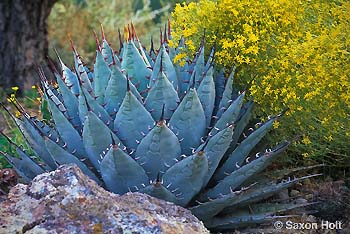
Agave neomexicana in Colorado zone 5
Now all Zone 5’s are not created equally, with different amounts of winter moisture, but if the garden concept is about what sort of tough succulents can be used as focal points in the garden, then the A. neomexicana photograph above tells that story for cold climates.
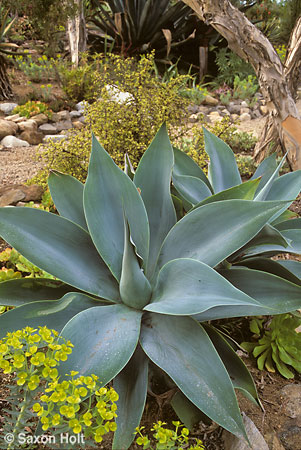
Agave attenuata in San Diego
This photograph did not appear in the book but is a photograph that tells the same story of using an agave as a focal point. But it would be unfair to show such a large Agave focal point to most gardeners in a national book. At the same time it is unfair to the California gardener to see a photo of a small specimen, lest they be misled about the amount of space the plant will take in the garden.
There are no easy ways to illustrate garden books and hopefully a good publisher will let the readers know where the photographs come from so that the information becomes authentic. I like to say in my own blog over at Gardening Gone Wild that the camera always lies, because it is so easy to misinterpret a photograph.
Like the soft foliage look of the Agave attenuata above? Here it is again, below.
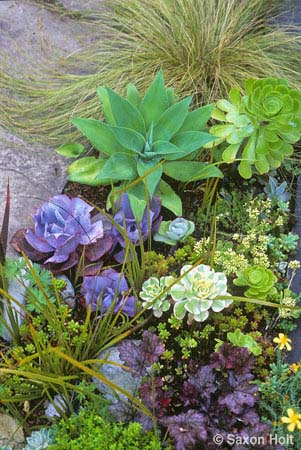
Tender succulents in annual border
Many gardeners in colder climates are realizing they can use succulents as annuals, as disposable as petunias and can create rich tapestries of shapes and foliage that delight and thrive until the first hard frost. Succulents also work well in containers that can be protected in winter.
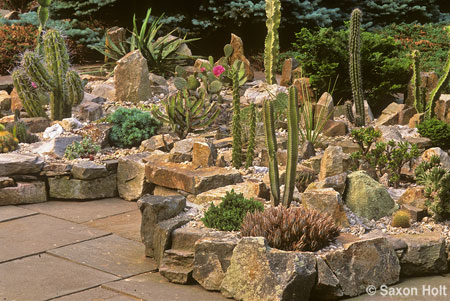
Connecticut desert - a container garden
Few gardeners will go to the trouble of putting an entire garden into containers, but seeing is believing. All the cactus succulents on the patio above are crammed into a small heated porch in the winter, then hauled out and buried in gravel for the summer.
I think I would just move to Southern California where the look is a little easier:
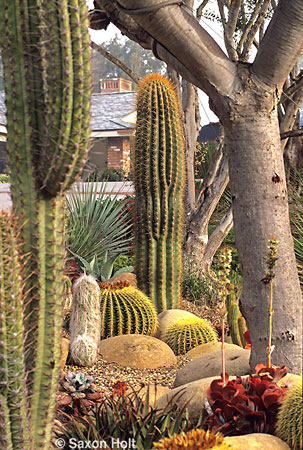
Southern California low maintenance garden
So much of good gardening is knowing which plants work in which climates and knowing hardiness is a major piece of information. Almost every climate has hardiness “issues”. Zone 5 gardeners are lucky compared to zone 3 die-hards.
When I started work on Hardy Succulents I really wanted to photograph the big bold succulents here in California but the publisher (Storey Publishing) and Gwen Kelaidis, my Denver co-author, were not fooled by my complaints of my own hardiness concerns. In my zone 9 garden (a cold climate compared to San Diego) I too have to bring in tender succulents.
Or I would grow these in my border:
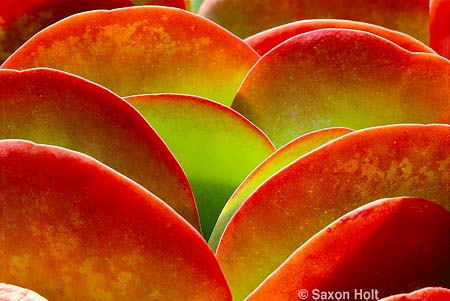
Kalanchoe thyrsiflora, tender succulent
Inspired by the layouts in the book I am preparing a photo show, a green wall of succulents. You can see them as a web gallery on my website.
Hardy Succulents is one of the prizes being offered in our scavenger hunt Have you entered yet?





We live in West michigan about 35 miles north of Grand Rapids. We have 25 acres and there are prickly pear all over the property. We are in zone 5b. I have also seen yucca in the area
I have a hardy prickly pear that wintered over (in a very dry bed) several of Michigans zone five winters.
Beautiful blossoms!
Jenn’s last blog post..Comments Moderation: The Horns of the Dilemma…
What a wise, generous essay. Thanks, both of you. And Saxon, there is always such a sense of authenticity to your images. I like their intimacy. I feel I get to know your subjects because you do.
Hello Kathy and Saxon ~ What a delightful post! I had the privilege of being seated across the table from Saxon at an impromptu garden writers/photographers/bloggers dinner (there were 10 0f us!) at a hip Cajun-style restaurant last month. It was after the SF Flower & Garden Show one night and we had a blast. Saxon, your work is breathtaking; the way you use light as an element of your compositions is just beautiful. I like what you’ve written here about learning to read and critique “place” when viewing a plant photograph. Now I will visit your blog, Cheers, Debra
debra’s last blog post..You say Toe-MAY-toe; I say Toe-MAH-Toe